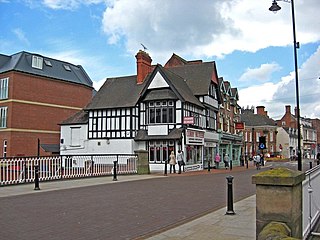
The Borough of Stafford is a local government district with borough status in Staffordshire, England. It is named after Stafford, its largest town, which is where the council is based. The borough also includes the towns of Stone and Eccleshall, as well as numerous villages and surrounding rural areas.

Staffordshire University is a public research university in Staffordshire, England. It has one main campus based in the city of Stoke-on-Trent and four other campuses; in Stafford, Lichfield, Shrewsbury and London.
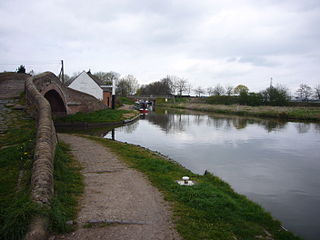
Great Haywood is a village in central Staffordshire, England, just off the A51 and about 4.5 miles (7.2 km) northwest of Rugeley and 7.1 miles (11.4 km) southeast of the county town of Stafford. Population details taken at the 2011 census can be found under Colwich.

Great Bridgeford is a village in the Borough of Stafford, Staffordshire, England, and a ward of Seighford civil parish. Population details taken at the 2011 census can be found under Seighford. It lies on the A5013 and is the point where the B5405 meets the A5013. The hamlet of Little Bridgeford is on the A5013 a short distance to the north.

Haughton is a village in Staffordshire, England, approximately 4 miles outside and to the west of the county town of Stafford. It lies on the A518 between Stafford and Gnosall. The name derives from a combination of the Mercian word halh meaning 'nook' and the Old English word tun meaning 'settlement', 'enclosure' or 'village.'

Weston-under-Lizard is a village and former civil parish, now in the parish of Blymhill and Weston-under-Lizard, in the South Staffordshire district of Staffordshire, England. It is known as Weston-under-Lizard to distinguish it from Weston-on-Trent. It should not be confused with the village of Weston, to the north east of Stafford. In 1961 the parish had a population of 294. On 1 April 1986 the parish was abolished and merged with Blymhill to form "Blymhill and Weston-under-Lizard".
Milford is a village in the county of Staffordshire, England. It lies at the edge of Cannock Chase, on the A513 road between Stafford and Rugeley. Just to the north of the village is the River Sow.
Doxey is a village and civil parish in the borough of Stafford in Staffordshire, England. It is a north-western suburb of Stafford. The village became a civil parish on 1 April 2005.

Creswell is a small village on the north-western edge of Stafford, the county town of Staffordshire, England situated on elevated ground above the wide floodplain and extensive marshes of the River Sow. Population details taken at the 2011 census can be found under Seighford.
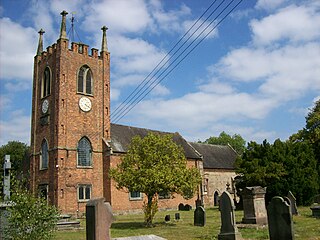
Seighford is a village and civil parish about 3 miles (5 km) west of Stafford in Staffordshire, England. The population of this civil parish at the 2011 census was 1,793. The ford across a small stream is the origin of the village's toponym. The village has a red brick Church of England parish church, St Chad's, and a 16th-century Tudor mansion.
Stafford Rural District was a rural district in the county of Staffordshire. It was created in 1894 and abolished in 1974 by virtue of the Local Government Act 1972. On formation it contained the following civil parishes:
Colwich is a civil parish and village in Staffordshire, England. It is situated off the A51 road, about 3 miles (5 km) north-west of Rugeley and 7 miles (11 km) south-east of Stafford. It lies principally on the north-east bank of the River Trent, near Wolseley Bridge and just north of The Chase. The parish comprises about 2,862 hectares (28.62 km2) of land in the villages and hamlets of Colwich, Great Haywood, Little Haywood, Moreton, Bishton and Wolseley Bridge.
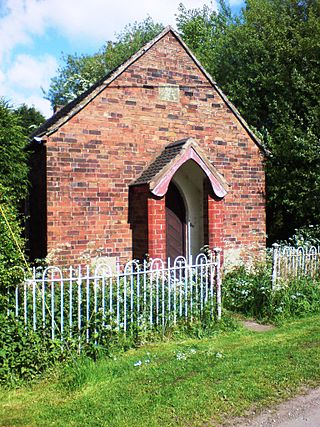
Coton Clanford is a small dispersed Staffordshire village lying in gently rolling countryside 3 miles due west of Stafford, England, and 1 mile southeast of Seighford. The name of the village is sometimes hyphenated to Coton-Clanford, appearing this way on some cottage names locally. The population for this village as taken at the 2011 census can be found under Seighford. It lies midway between the B5405 road, 1½ miles to the north and the A518 1½ miles to the south. The village has no shops, public houses or church, comprising only a few scattered houses and cottages, several dairy farms and a long disused 19th century chapel.

Dunston is a small village in England lying on the west side of the A449 trunk road about 3 miles (4.8 km) south of Stafford, close to Junction 13 of the M6 motorway. The population of the village at the 2011 census was 281. It lies at roughly 300 feet above sea level.
Chebsey is a small village in Staffordshire 2.5 miles southeast of Eccleshall on a confluence of Eccleshall water and the River Sow some 5 miles northwest of Stafford. The population of the civil parish at the 2011 census was 566. It comprises a number of houses and cottages and a village church dedicated to All Saints.
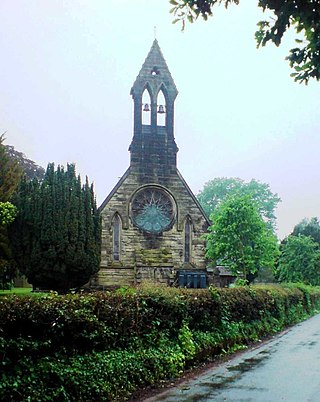
Salt is a village in the Borough of Stafford in Staffordshire, England. It is three miles northeast of Stafford situated half a mile southwest of the A51 trunk road and lying on elevated ground above the western side of the Trent valley. Population details as taken under the 2011 census are found under Seighford. The village has an ancient public house with a thatched roof, The Hollybush Inn, dating from the 17th century, reputedly much older, and a village hall.

Aqualate Hall, a 20th-century country house, is located in Forton, Staffordshire, England, some 2 miles (3.2 km) east of the market town of Newport, Shropshire and 10 miles (16 km) west of the county town of Stafford. It is a Grade II* listed building.

Hyde Lea is a village and parish in Staffordshire, England, just west of Stafford itself.
Seighford is a civil parish in the Borough of Stafford, Staffordshire, England. It contains 21 listed buildings that are recorded in the National Heritage List for England. Of these, two are at Grade II*, the middle of the three grades, and the others are at Grade II, the lowest grade. The parish contains the villages of Seighford, Derrington, and Great Bridgeford and the surrounding area. Most of the listed buildings are houses, cottages and associated structures, farmhouses and farm buildings, and a high proportion of these are timber framed or have a timber framed core. The other listed buildings consist of a church, a headstone in the churchyard, a public house, a bridge, and two mileposts.

Seighford Hall is a house that lies slightly to north-west of the core of Seighford, England. It appears to have later- 16th to early-17th origins but the radical later changes made to it – particularly in the 19th century – make an accurate assessment difficult. There seems to be no doubt that it was built on a greenfield site for the Elde family – and almost certainly for Richard Eld (1546–1621). In 1574 Richard Elde of Seighford was granted a coat of arms and crest by the Ulster King of Arms; Eld had been born in Derbyshire and had managed to be appointed Treasurer and Steward to the notorious Walter Devereux, 1st Earl of Essex and Earl Marshal of England (1541–76).














